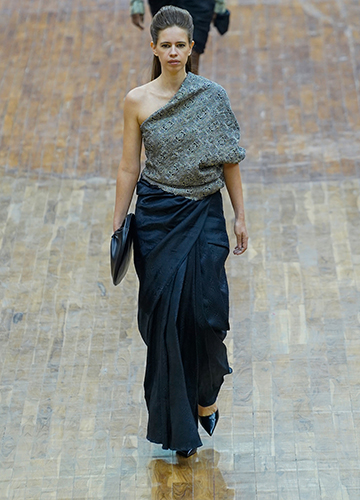Sanjay Garg’s Raw Mango opened the India Fashion Week in Delhi last week. Many say it also closed the fashion week, as all the chatter for the next few days was around his showcase alone. If you were among the other designers who got lost in the aftermath of the Raw Mango show, we are sorry.
Garg, 43, is elated with the noise. The collection―Children of the Night―was nothing if not intended to get people talking. It was quite unlike Garg’s mien, the designer let go of his Indian mood of saris and tunics soaking in a vintage aesthetic. It was still a textile-first line, but presented in new styles that one could only call a Euro-centric aesthetic. Reviews are divided, in equal parts blown over and bewildered.
Garg is jubilant when we speak the next day. “When I started designing, this world didn’t exist. Social media didn’t exist. People called saris “behenji”. And thought I was foolish,” he says of his 15-year-old fashion label, hallowed for its tasteful and antiquity-loving Chanderis and Benaresis. Garg’s superior tailoring, largely inspired by the Asian silhouette of tunic and trousers―either as salwar kameez, or churidar kurta or then just a long structured top with pencil pants―made brocade and woven metallics a thing of urban sophistication. He always presented the old as if it was a new thing, often taking a snipe at those who did not know all of this was seeped in India all along.
“Our thinking largely remains influenced by the west, whether it is in ideas or aesthetics. This collection is an invitation to rethink this,” he says. “If a sari brand can do this, a sari-wearing woman can do anything.” What he is referring to is a sea of sculptural clothes that moved from several types of jacket shapes, cocoon dresses, maxis, fitted dresses, oversize dresses, clothes that looked like lanterns, cinched waists and saris worn with undergarments. In many styles, the sari didn’t appear to look like a sari at all. The fabrics were extraordinary, metallics woven with silk, sequins flattened into the cloth, molten brass.
“This is the modern woman. If you think a sari cannot be a modern garment, let me provoke you. If you think the sari has not evolved, that’s your problem, not mine,” Garg says.
Garg’s choler is not saved for the fashion audience alone, it is also for his contemporaries. “Of course, I am looking at Europe as a market,” he says, “But it is very conservative of someone who says an Indian designer should do this only outside. Designers do western clothes in the west, and lehengas and cholis here in India.”
There is that famous story that Garg, who grew up in Mubarikpur in Rajasthan’s Alwar district, was ‘discovered’ by Good Earth founder Anita Lal at a Dilli Haat exhibition. She fell in love with his modern take on pop-coloured Chanderis and exhibited him at her posh store. Garg’s star has only risen since then. “I was an activist then and I am an activist now,” he swears. His village taught him the importance of a blank slate. “I was not influenced by anything. My whole journey has been about breaking stereotypes,” he says.
Raw Mango has been as much a traditional Indian label as it has been a disruptive one. In 2016, Garg presented a collection called ‘Monkey Business’ at Lakme Fashion Week in Mumbai. It showcased modern shapes in fitted dresses and tunic and jackets, but all in a Benaresi brocade woven with a monkey as a motif. “I don’t know why people in temples shoo away monkeys, almost as if they are a menace,” he had told me then. The collection was an homage to monkeys, who go where they want to and do as they feel like. The show took place on the beat of live drums, with the models walking around disjointedly, like the simians jumping from one branch on to another all at once.
“I am glad you can see the connection between the two lines, because there is one,” he says, “The brand is growing, each time I feel I have understood the recipe, I want to challenge it. It’s been a great journey but I am restless. I want a cultural revolution, and design is just a medium for me to achieve it. I still have so much I want to say.” Among his listeners, and loyal fans, are Shashi Tharoor, Ma Anand Sheela, Mahua Moitra and two dozen movie stars, some of who agreed to walk his runway not as showstoppers but blending in with the models themselves. (These were Karisma Kapoor, Kalki Koechlin and Saba Azad).
India, rural India, remains his perennial muse. “There are infinite possibilities of handloom. I want to make a handloom that stretches, that’s size free. New couture is not going to be about garment construction. New couture is going to be artisanal. The future of fashion is going to be about blurring boundaries between art forms and media―brass and wood will be worn. I want to make impractical pieces, fashion is about limitless possibilities.”
Garg’s contentions run contrary to his beautiful stores, each one is an oasis of calm. A reminder of Gandhian minimalism and austerity. The designer says he creates everything himself, even the knobs and wardrobes. There are no mannequins or window displays, just wardrobes, and shelves and racks. The designer is a polymath, he makes clothes, interiors, objets, and has even created music―his album ‘Ghar’ was released on Spotify during the lockdown of 2020. “There is only one word in Hindi for art―kala―this means all art is the same. In English we say ‘art’ and ‘craft’ and multiple other things, but in India, we cannot separate one from the other,” he says.



